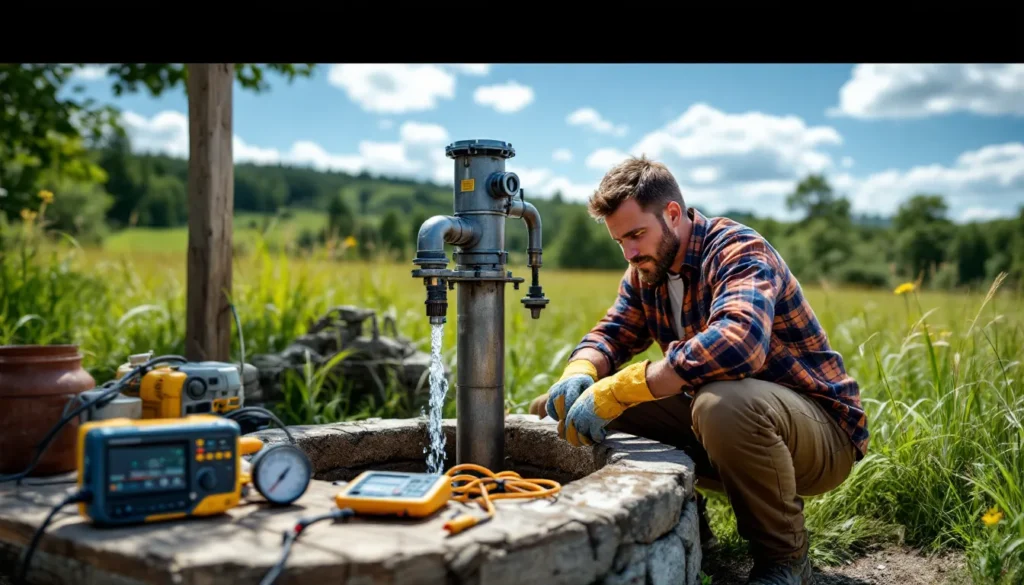Key Takeaways
- Regular Testing is Essential: Conducting consistent tests on your water pump ensures efficient operation, extends its lifespan, and prevents costly repairs.
- Use the Right Tools: Key instruments such as multimeters, pressure gauges, and vacuum gauges are crucial for accurate assessments during the testing process.
- Step-by-Step Testing Process: Follow a systematic approach—prepare the pump, conduct tests, and analyze results—to comprehensively evaluate pump performance.
- Identify Common Issues: Be aware of warning signs such as inconsistent water flow, unusual noises, and increased energy bills, which can indicate potential failures.
- Troubleshooting Strategies: Utilize effective troubleshooting tips to address common problems, ensuring your water pump operates smoothly and efficiently.
- Document Your Findings: Keeping a log of all test results helps track performance changes and informs future maintenance decisions to ensure reliability.
Testing a water pump might seem daunting, but it’s essential for ensuring your system runs smoothly. Whether you’re dealing with a well pump, sump pump, or any other type, knowing how to check its performance can save you time and money in the long run. You’ll want to keep your water supply reliable and avoid unexpected breakdowns.
Importance Of Testing A Water Pump
Testing a water pump ensures its efficient operation and reliability. Regular testing helps identify potential issues before they escalate into major problems. Consistent testing contributes to prolonged lifespan, lower repair costs, and minimized downtime.
Proper testing also confirms adequate water flow and pressure. Insufficient flow can affect daily activities, from irrigation to household needs. Understanding performance metrics keeps you informed about your water supply’s reliability.
Timely inspections prevent costly breakdowns. Addressing minor deficiencies early can save significant expenses associated with emergency repairs. Regularly testing pumps like well pumps and sump pumps safeguards the integrity of your water sources.
Optimizing pump performance maximizes energy efficiency. A well-functioning pump typically consumes less power, leading to reduced utility bills. Regular performance evaluations help detect inefficiencies, allowing for adjustments that enhance sustainability.
Testing a water pump reinforces safety measures. Malfunctioning pumps can lead to hazardous situations, such as flooding or contamination. By ensuring proper functioning, you maintain a safe environment for your family and property.
Tools Needed For Testing

Testing a water pump requires specific tools to ensure accurate assessments. Using the right equipment enhances efficiency and effectiveness during the process.
Essential Equipment
- Multimeter
A multimeter measures voltage and current, allowing you to check electrical connections and ensure the pump receives adequate power.
- Pressure Gauge
A pressure gauge monitors the water pressure in the system. This tool helps you determine if the pump operates within the recommended pressure range.
- Hose Clamp
Hose clamps secure hoses and connections, preventing leaks during testing. Ensuring a tight fit leads to more accurate measurements.
- Vacuum Gauge
A vacuum gauge examines suction pressure, especially for submersible pumps. This tool identifies issues with suction performance.
- Wrench Set
Wrenches assist in loosening or tightening connections. A proper fit prevents damage to fittings and enables adjustments as necessary.
Optional Accessories
- Flow Meter
A flow meter measures the rate of water flow produced by the pump. This accessory provides insights into the efficiency of the pump’s performance.
- Water Quality Tester
A water quality tester assesses the quality of the water being pumped. Understanding water quality ensures safe usage, especially in potable applications.
- Bucket or Container
A bucket collects water during testing. This simple tool allows you to visually inspect the quantity and quality of the pumped water.
- Extension Cord
An extension cord provides power access when testing electric pumps in hard-to-reach areas. Ensure the cord is rated for outdoor use if necessary.
- Camera or Smartphone
A camera captures images or videos of the pump setup and conditions. Documenting findings assists in troubleshooting and future maintenance assessments.
Step-By-Step Guide On How To Test A Water Pump
Testing a water pump involves several straightforward steps that ensure the pump operates effectively. Follow this guide to assess your pump’s performance accurately.
Preparing The Pump
- Turn Off the Power: Ensure safety by disconnecting the power supply to the water pump. This step prevents any electrical accidents during testing.
- Check for Leaks: Inspect the pump and surrounding areas for any visible leaks. Identifying leaks early helps avoid further complications.
- Gather Tools: Collect essential tools, including a multimeter, pressure gauge, vacuum gauge, and hose clamps. These tools facilitate precise evaluations.
- Clear the Area: Remove any obstructions around the pump, providing easy access for testing. A clear workspace promotes safety and efficiency.
- Prepare the Hose: If testing a submersible well pump, ensure that the discharge hose is properly attached and secured with hose clamps. An improper connection affects test accuracy.
Conducting The Test
- Connect the Pressure Gauge: Attach the pressure gauge to the discharge point of the pump. Monitor the readings as the pump operates to determine output pressure.
- Power On the Pump: Restore power to the pump and allow it to run for a few minutes. Observe how quickly it reaches the operating pressure.
- Monitor Flow Rate: If using a flow meter, measure the water flow rate during the test. Compare this rate to the pump’s specification to assess performance.
- Check Electrical Components: Use a multimeter to inspect electrical connections. Ensure voltages are within the manufacturer’s recommended range for optimal operation.
- Evaluate Suction Pressure: For pumps requiring suction, install the vacuum gauge on the inlet. Record the suction pressure while the pump operates.
Analyzing The Results
- Review Pressure Readings: Compare the pressure gauge readings against the pump’s specifications. Inconsistent results could indicate potential mechanical issues.
- Examine Flow Rate: Assess the flow rate against manufacturer standards. Low flow rates typically suggest clogs or mechanical failures.
- Check Electrical Functionality: Ensure that electrical readings from the multimeter are consistent with the pump’s requirements. Discrepancies may point to wiring issues.
- Identify Anomalies: Note any unusual noises or vibrations during operation. These may indicate underlying mechanical problems requiring further investigation.
- Document Findings: Record all test results in a log for future reference. Regular documentation helps track performance changes over time.
Common Issues To Look For
Identifying issues in a water pump ensures smooth operation and prolongs its lifespan. Here are common problems to be aware of during your testing process.
Signs Of Pump Failure
- Inconsistent Water Flow: An uneven or fluctuating water flow often indicates potential pump problems.
- Strange Noises: Unusual sounds like grinding, whining, or rattling may signal internal damage or wear.
- Increased Energy Bills: A sudden spike in energy costs suggests the pump may be working harder than normal, indicating inefficiency.
- Vibrations: Excessive vibrations during operation can point to misalignment or imbalance in the pump.
- Overheating: If the pump becomes excessively hot, it may indicate mechanical failure or insufficient lubrication.
- Leaking: Water leaking around the pump base or from hoses often denotes seal failure or loose connections.
- Air Locks: Air bubbles in the system can lead to reduced efficiency, indicating an issue with suction or water intake.
Troubleshooting Tips
- Check Electrical Connections: Ensure all connections are tight and free of corrosion. Inspect wires for any damage.
- Inspect the Impeller: Remove and clean the impeller, as clogs can hinder water flow.
- Examine For Leaks: Tighten all fittings and replace any worn-out seals or gaskets.
- Monitor Pressure Readings: Compare readings against manufacturer specifications to confirm proper operation.
- Test Motor Functionality: Verify that the motor starts and runs smoothly without abnormal noises.
- Clear Blockages: Remove debris from intake screens and check piping for obstructions.
- Replace Worn Parts: Change any parts showing significant wear or damage to restore efficiency.
Implementing these troubleshooting steps helps maintain your water pump’s functionality and prevent further issues.
Conclusion
Testing your water pump is essential for maintaining a reliable water supply and preventing costly repairs. By regularly assessing its performance and addressing any issues promptly, you can extend the lifespan of your pump and enhance its efficiency.
Utilizing the right tools and following a systematic testing process allows you to identify problems early. This proactive approach not only saves you money but also ensures a safe environment for your family.
Make water pump testing a routine part of your maintenance schedule. You’ll enjoy peace of mind knowing your system functions optimally and is ready to meet your daily needs.

Hi, I’m Md Rofiqul, a gardening enthusiast who loves spending time in the garden and backyard. I enjoy caring for plants, growing flowers and vegetables, and creating a green space that feels peaceful and refreshing. Gardening is more than just a hobby, it’s a passion that connects me to nature and brings joy to my daily life. Living with plants inspires me to embrace simplicity, patience, and sustainability while making every day more colorful and rewarding.
